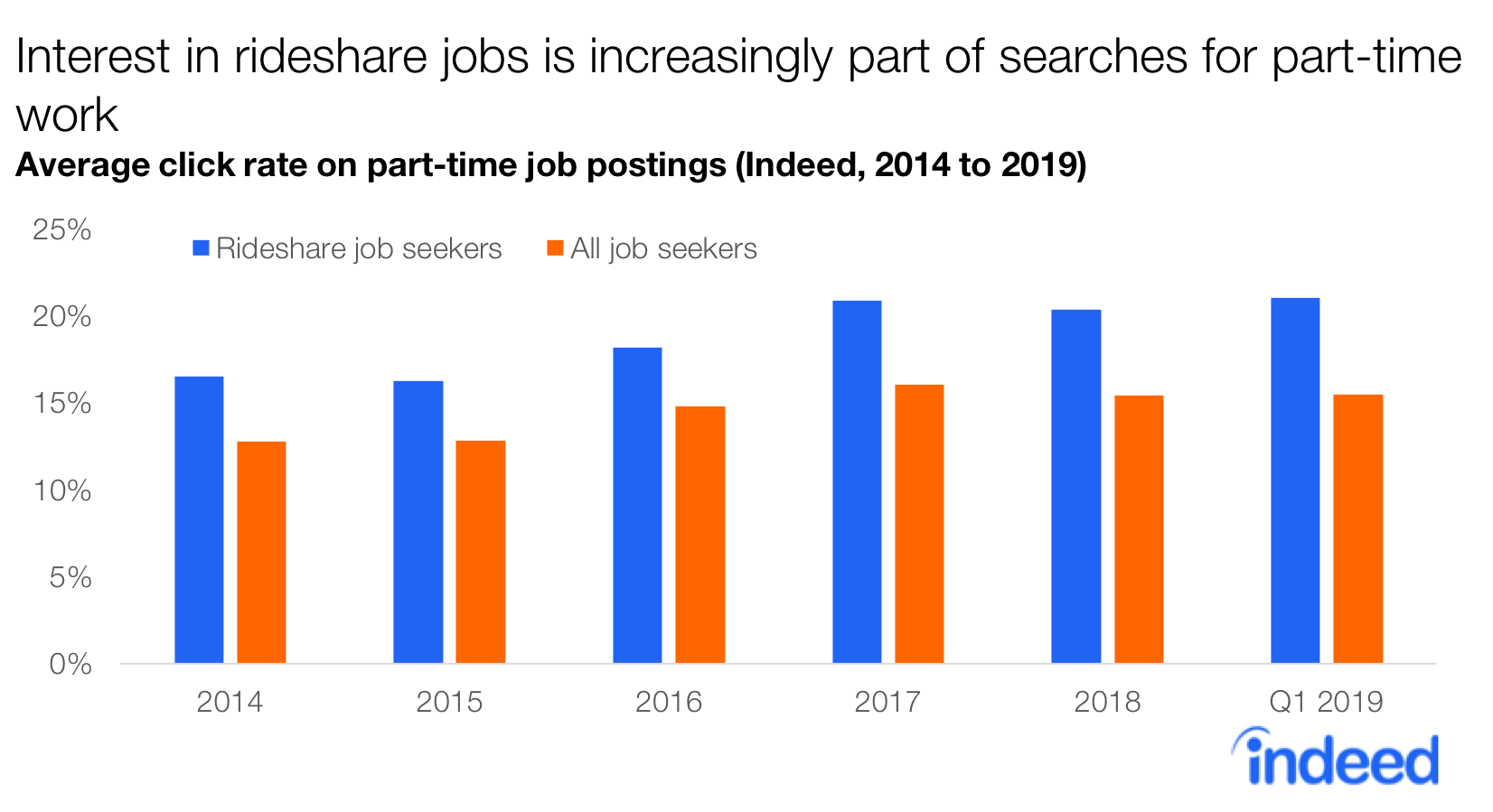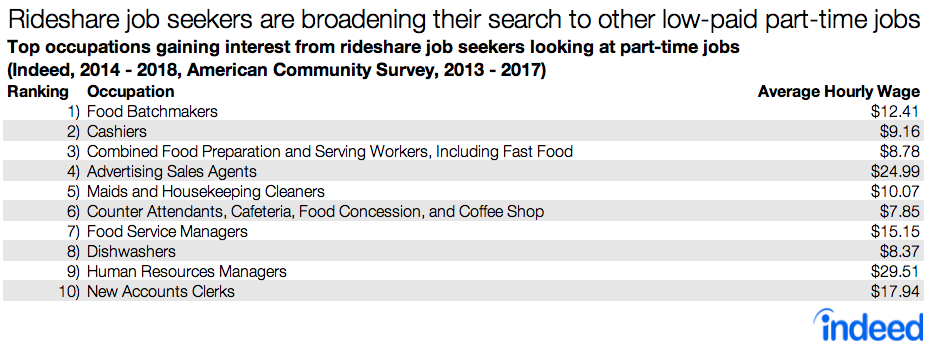Key Points
- Job seekers who click on rideshare jobs are doing so while looking at non-rideshare driving jobs too, and have done so for years.
- Rideshare job seekers are increasingly interested in part-time work outside of ridesharing, specifically part-time work in low-wage occupations.
- Retailers, restaurants, and other employers looking to fill part-time positions should consider how they might compete against rideshare gigs for workers.
Rideshare companies like Uber and Lyft will need to contend with the changing pool of potential drivers as they enter public investment markets and continue to mature. As rideshare services have become more mainstream and the labor market has tightened, interest in rideshare jobs on Indeed is increasingly coming from workers who are looking for part-time work. More and more, it seems rideshare companies will have to compete with traditional employers of part-time work, such as retailers and restaurants.
Interest in rideshare jobs on Indeed has been, and continues to be, disproportionately coming from job seekers who are interested in driving opportunities in general. However, the composition of rideshare job seekers is changing. More interest is coming from job seekers who are interested in part-time work. Importantly, these job seekers are increasingly interested in low-paid part-time work—and, unlike many low-paid roles, rideshare jobs offer the ability to create your own hours.
As the job seeker interest in rideshare jobs evolves, Uber, Lyft and other rideshare companies won’t be the only employers who need to react. Increased competition for the interest of part-time job seekers will force employers reliant on part-time work to react by making their positions more attractive to these job seekers.
The pool of rideshare drivers has been changing
Since 2014, when job seekers look at rideshare jobs, they are very likely doing so while also looking for another driving job. During the first three months of 2019, a job seeker who clicks on a rideshare job postings is almost three times as likely as the average job seeker to click on a taxi driver job. Rideshare jobs are, for the most part, considered to be just another option for job seekers interested in driving for money. However, the interests of rideshare job seekers are changing in two ways.

In 2014, the average rideshare job seeker was 29% more likely than the average job seeker to look at a non-rideshare part-time job posting. But during the first three months of 2019, the average job seeker who clicked on a rideshare job posting was roughly 36% more likely to click on a non-rideshare part-time posting. At the same time, they were 11% less likely to click on a full-time position than the average job seeker, showing that rideshare jobs appear to now be another option for workers looking for part-time positions.

As the pool of rideshare job seekers evolved and became more likely to check out part-time jobs over the past four years, they shifted the kind of part-time work they are interested in outside of ridesharing toward positions in low-paid occupations such as cashier and dishwasher. And in a sign that the rideshare job seekers of today are moving away from driving in their search for non-rideshare jobs, the occupation that saw the second largest decline in part-time interest was taxi driver and chauffeur.

Low-wage employers competing for rideshare workers
With these new options, traditional employers of part-time work will need to react. If workers who consider cashier or fast food server jobs are now looking at rideshare jobs, possibly on the promise that they will have more control over their hours, employers hiring for more traditional part-time jobs need to think about how they’ll attract and retain those workers. Ridesharing doesn’t look like it’s going away anytime soon and traditional part-time employers will have to adjust accordingly.
Methodology
We define a job seeker as interested in rideshare jobs if they clicked on Indeed job postings for driver positions with Lyft or Uber.
Our measure of occupation is the six-digit Standard Occupation Code.
Our measure of job seeker interest full-time and part-time positions is based on clicks on postings on Indeed.com. We calculate share of clicks by job seekers who clicked on rideshare postings on non-rideshare postings for exclusively full-time work and exclusively part-time work, and then do the same for all job seekers on Indeed. We then divide the rideshare job seeker share by the overall job seeker share to get an interest ratio for both full-time postings and part-time postings. The higher the ratio, the more relative interest from rideshare clickers compared with the total job seeker population. We did these calculations for 2014 through 2018 and the first quarter of 2019.
To see the interest in occupations, we did the same analysis as full-time and part-time work but instead look at the shares of clicks on postings categorized by six-digit Standard Occupation Code.
We calculated the average hourly wage using data from the American Community Survey from 2013 to 2017. Only observations for workers employed at least 50 weeks in a year were used.
The relationship between the shift in interest in part-time postings from rideshare job seekers and average wages in an occupation was determined by regressing the change in the relative interest of rideshare job seekers from 2014 to 2018 on the average wage in an occupation. The correlation is negative and statistically significant at the 1% level.






